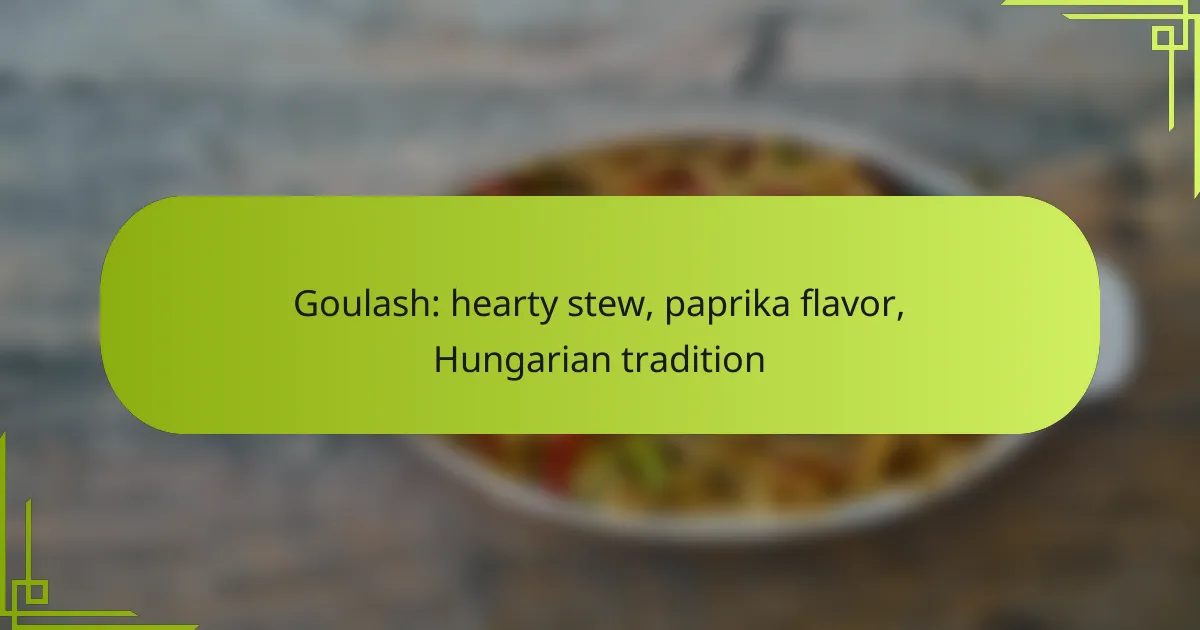Goulash is a hearty stew that embodies the rich culinary tradition of Hungary, renowned for its robust paprika flavor. This savory dish typically features tender beef simmered with a medley of vegetables and spices, creating a comforting meal that warms the soul. To truly appreciate goulash, it’s essential to focus on quality ingredients and traditional cooking methods that highlight its deep, flavorful profile.

How to make authentic Hungarian goulash?
To make authentic Hungarian goulash, focus on using quality ingredients and traditional methods. This hearty stew is characterized by its rich paprika flavor and tender meat, typically beef, simmered with vegetables and spices.
Traditional ingredients
The key ingredients for authentic Hungarian goulash include beef, onions, garlic, bell peppers, tomatoes, and of course, paprika. Hungarian sweet paprika is essential for achieving the signature flavor, while caraway seeds and bay leaves add depth. Some variations may include potatoes or carrots for added heartiness.
When selecting beef, choose cuts like chuck or shank that become tender with slow cooking. Fresh vegetables enhance the stew’s flavor, so opt for seasonal produce whenever possible.
Cooking methods
Goulash is traditionally prepared in a large pot or cauldron over an open flame, but it can also be made on a stovetop or in a slow cooker. Start by sautéing onions until golden, then add the beef and brown it on all sides. Incorporate the paprika and other spices before adding liquid, typically water or broth, to cover the ingredients.
Allow the stew to simmer gently for several hours, stirring occasionally. This slow cooking process helps develop the rich flavors and tenderizes the meat. If using a slow cooker, set it on low for about 6 to 8 hours.
Serving suggestions
Authentic Hungarian goulash is often served with crusty bread or dumplings to soak up the flavorful broth. A dollop of sour cream on top can add a creamy contrast to the dish. For a complete meal, consider pairing goulash with a side salad or pickled vegetables.
In Hungary, goulash is commonly enjoyed as a main course during family gatherings or festive occasions. It can also be served in smaller portions as a starter or appetizer, showcasing its versatility.

What are the key flavors in goulash?
The key flavors in goulash primarily revolve around the rich taste of paprika, complemented by a blend of herbs and spices. This hearty stew, rooted in Hungarian tradition, features a savory base that balances the warmth of spices with the depth of meat and vegetables.
Role of paprika
Paprika is the cornerstone of goulash, providing its signature color and flavor profile. Hungarian paprika, known for its sweet and smoky notes, is preferred for authenticity, while other varieties can add different dimensions.
When using paprika, consider the heat level; sweet, hot, and smoked paprika can all be used depending on personal preference. A typical goulash recipe might call for a few tablespoons of paprika, but adjust to taste for a more pronounced flavor.
Herbs and spices
In addition to paprika, goulash often includes herbs and spices such as caraway seeds, bay leaves, and sometimes thyme or marjoram. These ingredients enhance the stew’s complexity and aromatic qualities.
When preparing goulash, it’s common to add these herbs early in the cooking process to allow their flavors to meld. A good rule of thumb is to use about one teaspoon of dried herbs per pound of meat, adjusting based on the specific herbs used and personal taste preferences.

Where to find the best goulash in Canada?
Canada offers a variety of places to enjoy authentic goulash, especially in cities with vibrant culinary scenes. Look for Hungarian restaurants or Eastern European eateries that specialize in traditional dishes to experience the best flavors.
Top restaurants in Toronto
In Toronto, several restaurants are renowned for their goulash. One standout is Hungary Restaurant, which serves a rich, paprika-infused goulash that captures the essence of Hungarian cuisine. Another popular spot is Goulash House, where you can find a hearty version made with tender beef and served with fresh bread.
When visiting these establishments, consider trying their homemade dumplings as a side, which complement the stew perfectly. Reservations are recommended during peak dining hours to ensure a table.
Popular eateries in Vancouver
Vancouver boasts a selection of eateries that serve delicious goulash. European Deli is a favorite, offering a classic goulash that’s both hearty and flavorful, often paired with a side of potato pancakes. Another great option is Hungarian House, known for its cozy atmosphere and authentic recipes.
Be sure to check their daily specials, as some places offer variations on traditional goulash that can include different meats or vegetarian options. Enjoying a glass of local wine can enhance the meal experience as well.

What variations of goulash exist?
Goulash has several variations that reflect regional preferences and dietary choices. The most common types include beef goulash, which is traditional in Hungary, and vegetarian goulash, which caters to those seeking meat-free options.
Beef goulash
Beef goulash is the classic version of this hearty stew, characterized by tender chunks of beef simmered in a rich paprika-infused broth. Typically, it includes ingredients like onions, garlic, bell peppers, and tomatoes, creating a robust flavor profile.
When preparing beef goulash, it’s essential to choose the right cut of meat, such as chuck or brisket, which become tender with slow cooking. Cooking times can vary, but expect to simmer the stew for at least one to two hours to develop deep flavors.
Vegetarian goulash
Vegetarian goulash offers a meatless alternative while still delivering the comforting essence of the traditional dish. This version often substitutes beef with hearty vegetables like potatoes, carrots, and mushrooms, along with beans or lentils for added protein.
To make vegetarian goulash, sauté the vegetables until tender, then add paprika and other spices to create a flavorful base. Simmering for about 30 to 45 minutes allows the flavors to meld, making it a quick yet satisfying meal option.

How to pair drinks with goulash?
Pairing drinks with goulash enhances the meal’s rich flavors. Consider wines and beers that complement the stew’s hearty paprika notes and savory ingredients.
Best wines
When selecting wines to pair with goulash, opt for medium to full-bodied reds. Varieties like Cabernet Sauvignon, Merlot, or a Hungarian red such as Egri Bikavér (Bull’s Blood) work well, as their tannins balance the dish’s richness.
For white wine enthusiasts, a dry Furmint or a light-bodied Sauvignon Blanc can provide a refreshing contrast to the stew’s depth. Aim for wines with moderate acidity to enhance the overall dining experience.
Recommended beers
For beer pairings, consider a malty Märzen or a robust Dunkel. These styles complement the hearty nature of goulash while their sweetness balances the spice from the paprika.
Additionally, a Belgian Dubbel can offer fruity and caramel notes that harmonize with the dish’s flavors. Avoid overly hoppy beers, as they may overpower the stew’s taste.

What are the health benefits of goulash?
Goulash offers several health benefits, primarily due to its rich ingredients like lean meats, vegetables, and spices. This hearty stew can provide a balanced meal with protein, vitamins, and minerals, making it a nutritious option for many diets.
Nutritional value
Goulash typically contains a variety of ingredients, including beef or pork, potatoes, carrots, and bell peppers, which contribute to its overall nutritional profile. A standard serving can provide a good source of protein, essential vitamins such as B6 and C, and minerals like iron and potassium.
Depending on the recipe, goulash can be relatively low in calories, especially when made with lean cuts of meat and plenty of vegetables. A serving might range from 300 to 500 calories, making it a filling yet moderate choice for a meal.
Comfort food aspects
Goulash is often considered a quintessential comfort food, providing warmth and satisfaction, especially in colder months. Its rich, paprika-infused flavor and hearty texture can evoke feelings of nostalgia and home-cooked meals.
The communal aspect of sharing goulash with family or friends enhances its comfort food status. It is commonly served during gatherings and celebrations, reinforcing social bonds while delivering a nourishing experience.

How has goulash evolved over time?
Goulash has transformed from a simple shepherd’s meal into a beloved dish with numerous regional variations. Originally a rustic stew, it now features diverse ingredients and cooking methods, reflecting culinary influences from various cultures.
Historical origins
Goulash traces its roots to Hungary in the 9th century, where it was initially prepared by shepherds using meat, vegetables, and spices. The dish gained prominence in the 19th century, becoming a staple in Hungarian cuisine and a symbol of national identity.
Traditional goulash typically includes beef, onions, and paprika, with variations incorporating potatoes or other vegetables. The use of paprika, introduced to Hungary from the Americas, became a defining characteristic, enhancing the stew’s flavor and color.
Modern adaptations
Today, goulash has many adaptations, reflecting local tastes and available ingredients. In addition to the classic Hungarian version, you can find variations in countries like Austria, Slovakia, and the Czech Republic, each adding unique elements such as different meats or spices.
Modern chefs often experiment with goulash by incorporating ingredients like beans, lentils, or even seafood, creating lighter versions or vegetarian alternatives. These adaptations maintain the essence of goulash while catering to contemporary dietary preferences.










